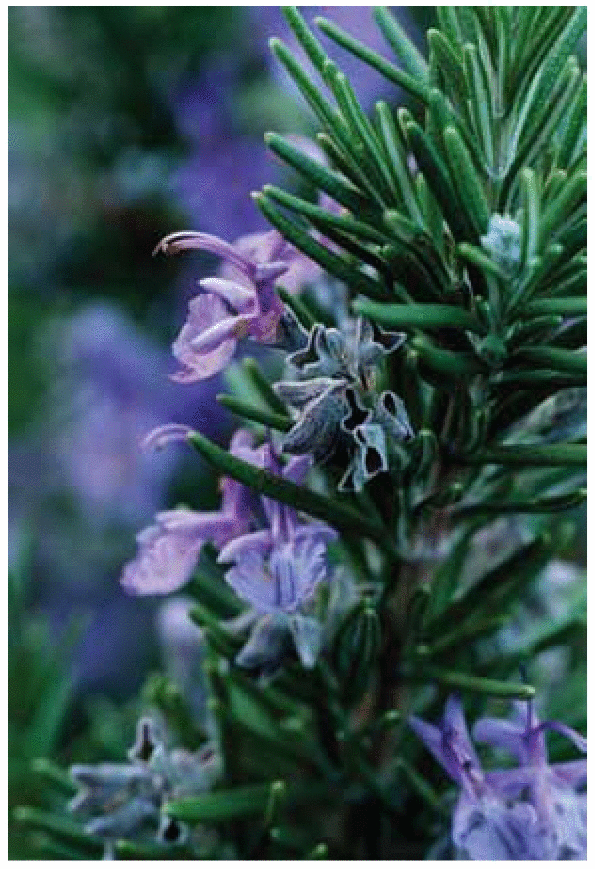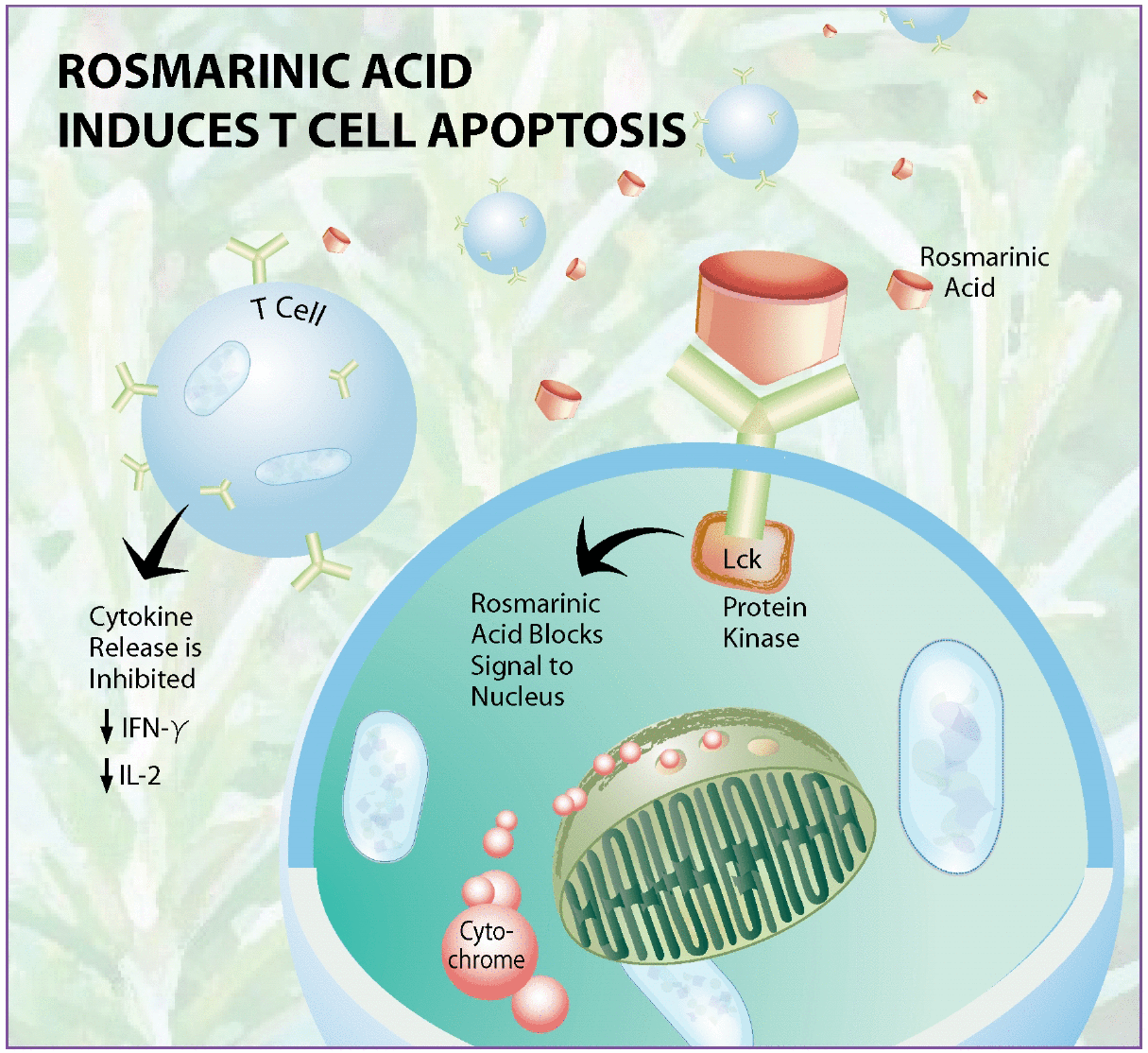Abstract
Rosmarinic acid has been shown to selectively induce T cell apoptosis in aberrant lymphocytes, but not normal/quiescent T cells. Rosmarinic acid also reduces gamma interferon driven T cell responses and reduces interleukin production following T cell stimulation. Furthermore, rosmarinic acid affects signal transduction inside T cells by affecting specific tyrosine kinase enzymes inside the cell. By direct effects on T cells as well as other anti-inflammatory and antioxidant effects, rosmarinic acid may be a safe and valuable tool for reducing autoimmune inflammation. It may also be safe and advantageous to use in tandem with pharmaceutical treatment of autoimmune diseases.
AARM REFERENCE REVIEWSThese are AARM reference reviews in which clinicians can obtain a quick overview of understanding with respect to how herbs, nutrients, and hormones can be used effectively in clinical practice. The dosages recommended are based on therapeutic results. Side effects that have not been seen in clinical experience or found in clinical studies but only been theorized have been identified and depicted as Unsubstantiated Theoretical Concerns. Since many nutrients and herbs on the market have not gone through double-blind studies but have been used extensively in clinical settings for hundreds, and for some thousands of years, these reference reviews have attempted to give a unified opinion on how to use these herbs effectively. The opinions expressed are from different professors and experts in the field of nutritional and botanical medicine. Some information is based on personal opinions and can not be quantified as fact. However, if clinicians only restricted themselves to what is fully proven by double-blind studies, the art of healing and restoring health with nutrients and herbs would be lost. |
CLINICAL IMPLICATIONS
Autoimmune diseases are among the most challenging to treat. Conventional medical therapies are immunosuppressive agents that suppress symptoms, but also have undesirable side effects. An effective alternative therapy without these side effects would be extremely valuable. Rosmarinic acid, which has been used in multiple sclerosis and thyroid autoimmune disease, may be such an alternative therapy.
PRIMARY INDICATION:
Autoimmune diseases, allergies and inflammation
ADJUNCTIVE OR STAND ALONE TREATMENT:
Adjunctive
BIOACTIVE CONSTITUENTS:
150-500 mg bid
TIME TO CLINICAL IMPROVEMENT:
Changes in lab tests or symptomatology can occur within four weeks.
LAB TEST TO ASSESS EFFICACY:
Tests specific to the condition being treated
SYNERGISTIC COMBINATION:
Unknown
SIDE EFFECTS:
Consume with food and water to prevent possible gastric irritation
PROVEN DRUG INTERACTION:
None documented
DISCUSSION
Rosmarinic acid is a caffeic acid derivative found in the Nepetoideae branch of the Lamiaceae (Mint) family including Rosmarinus officinalis, Prunella vulgaris, Melissa officinalis, Coleus spp., and Salvia officinalis, and several members of the Boraginaceae family including the genus Lithospermum. Rosmarinic acid is synthesized in plants from the amino acids phenylalanine and tyrosine involving at least eight enzymatic steps. Botanical research has identified several specific genes involved with the synthesis of rosmarinic acid.
ROSMARINIC ACID AND IMMUNE FUNCTION
Early animal and molecular studies found rosmarinic acid had antimicrobial, antioxidant, and anti-inflammatory benefits. These anti-inflammatory actions may be particularly useful in the treatment of autoimmune diseases. Additionally, rosmarinic acid is being studied as an anti-rejection agent for transplant patients. The herb may also possess the ability to modulate neuroendocrine function.
T CELLS, APOPTOSIS AND AUTOIMMUNE DISEASE
T cells are lymphocytes largely responsible for the destructive processes that occur in both autoimmune diseases and organ transplant rejection. Inhibiting T cells with immunosuppressive agents is the primary therapy for autoimmune disease and transplant patients. Once started, these immunosuppressants typically must be used by the transplant patient for life. Many of the immunosuppressive drugs used for autoimmune diseases suppress white blood cell activity and induce apoptosis in T cells, NK cells and other lymphocytes as a means of controlling pain, reducing symptoms, and slowing or preventing skin, tissue, and joint destruction. Research results reveal that rosmarinic acid can induce T cell apoptosis (programmed cell death) and reduce auto-inflammatory activity in a similar manner but apparently without the risks and long-term side effects of immunosuppressive therapy.
ROSMARINIC ACID AND T CELL ACTIVATION
A region on the nuclear DNA of lymphocytes, called the SH2 domain, appears to be involved in directing T cell activities and thus playing a role in cancer, autoimmune, and inflammatory diseases. Rosmarinic acid has been shown to act as an agonist at the SH2 domain and inhibit T cell activity in vitro. Rosmarinic acid has also been shown to reduce the ability of activated T cells to promote pro-inflammatory interleukin production and release.
ROSMARINIC ACID AND PROTEIN KINASE SIGNAL TRANSDUCTION
One mechanism of T cell inhibition may involve protein kinase enzymes. There are numerous protein kinases that play important roles in translating signals from cellular receptors to the interior of cells to ultimately act on the cellular DNA This process, called signal transduction, directs certain cellular activities. Lck, a tyrosine protein kinase, is specific to T cell signal transduction. Rosmarinic acid has been shown to inhibit activity between the Lck tyrosine kinase and a downstream peptide, thereby reducing signal transduction in T cells. Importantly, disrupted Lck signal transduction promotes apoptosis only in T cells that are actively proliferating, not T cells at rest. This is extremely significant since it suggests that rosmarinic acid may reduce a hyperactive immune response while preserving appropriate lymphocyte function.

Rosmarinus officinalis of the Labitae family
© Steven Foster Group, Inc.
T CELL RECEPTORS AND ROSMARINIC ACID
T cell antigen receptors are located on T lymphocytes and enable the cell to recognize and respond to outside influences, microbes, and a wide variety of antigens. Binding of an antigen or other activator to these receptors promotes a number of reactive processes inside the cell (Fig 1). The molecules involved with transducing the signal to the nuclear DNA are called transcription factors. Two such factors are the nuclear factor of activated T cells and activating protein. A domino effect of molecular activation can ultimately lead to T cell activation, the release of interleukins from T cells, and promotion of inflammatory and immune responses. Rosmarinic acid has been found to inhibit nuclear factor of activated T cells, but not activating protein. This mechanism is shared by non-steroidal anti-inflammatory drugs.

Rosmarinic acid was able to induce apoptosis in activated T cells taken from patients with rheumatoid arthritis. In this study, rosmarinic acid appeared to induce the release of cytochrome C from mitochondria which in turn induced apoptosis in ex vivo human T cells.
In addition, rosmarinic acid reduced inflammation in an animal model of collagen-induced arthritis. Animals treated with rosmarinic acid displayed markedly reduced levels of synovial inflammatory markers (e.g. cyclooxygenase) compared to control animals.
ROSMARINIC ACID AND TRANSPLANT MEDICINE
Rosmarinic acid is also being explored as a medicine to reduce transplant rejection. Animal research revealed that rosmarinic acid reduces the antibody attack on transplanted tissue. One group of researchers investigated the ability of rosmarinic acid alone and in combination with the immunosuppressive drugs cyclosporine, prednisone or rapamycin to inhibit proliferation of splenic T cells in animals that had undergone skin grafts as a model of graft versus host disease. The study showed that rosmarinic acid worked synergistically with the immunosuppressive drugs and decreased the transplant rejection response. Since anti-rejection drugs have a number of undesirable side effects that increase with dose, co-administration of rosmarinic acid could reduce the total required dose of immunosuppressant medication.
DISCLOSURE OF INTERESTS
Dr. Saunders reports personal fees related to employment or seeing patients from CCNM, the Dundas Naturopathic Centre, and from Beaumont Health Systems, Troy Hospital, MI, outside the submitted work. Dr. Winston reports personal fees from Herbalist & Alchemist, Inc, outside the submitted work. Dr. Zampieron reports royalties from a product he has developed for Restorative Formulations with rosmarinic acid as one of its therapeutic ingredients, outside the submitted work. Dr. Stansbury has nothing to disclose.
REFERENCES
- Ibarra A, Cases J, Bily A et al. Importance of extract standardization and in vitro/ex vivo assay selection for the evaluation of antioxidant activity of botanicals: a case study on three Rosmarinus officinalis L. extracts.
- Fang L, Lin N, Wu Y. [Simultaneous determination of four active components in Spica Prunellae by HPLC].
- Weitzel C, Petersen M. Enzymes of phenylpropanoid metabolism in the important medicinal plant Melissa officinalis L.
- Petersen M, Abdullah Y, Benner J et al. Evolution of rosmarinic acid biosynthesis.
- Ben FM, Jordan MJ, Chaouech-Hamada R, Landoulsi A, Sotomayor JA. Variations in essential oil, phenolic compounds, and antioxidant activity of tunisian cultivated Salvia officinalis L.
- Yamamoto H, Inoue K, Yazaki K. Caffeic acid oligomers in Lithospermum erythrorhizon cell suspension cultures.
- Moreno S, Scheyer T, Romano CS, Vojnov AA. Antioxidant and antimicrobial activities of rosemary extracts linked to their polyphenol composition.
- Jung dY, Kim EY, Joo SY et al. Prolonged survival of islet allografts in mice treated with rosmarinic acid and anti-CD154 antibody.
- Auf’mkolk M, Amir SM, Kubota K, Ingbar SH. The active principles of plant extracts with antithyrotropic activity: oxidation products of derivatives of 3,4-dihydroxycinnamic acid.
- Hur YG, Suh CH, Kim S, Won J. Rosmarinic acid induces apoptosis of activated T cells from rheumatoid arthritis patients via mitochondrial pathway.
- Park SH, Oh HS, Kang MA et al. The structure-activity relationship of the series of non-peptide small antagonists for p56lck SH2 domain.
- Kang MA, Yun SY, Won J. Rosmarinic acid inhibits Ca2+-dependent pathways of T-cell antigen receptor-mediated signaling by inhibiting the PLC-gamma 1 and Itk activity.
- Won J, Hur YG, Hur EM et al. Rosmarinic acid inhibits TCR-induced T cell activation and proliferation in an Lck-dependent manner.
- Hur YG, Yun Y, Won J. Rosmarinic acid induces p56lck-dependent apoptosis in Jurkat and peripheral T cells via mitochondrial pathway independent from Fas/Fas ligand interaction.
- Paccani SR, Boncristiano M, Ulivieri C, D’Elios MM, Del PG, Baldari CT. Nonsteroidal anti-inflammatory drugs suppress T-cell activation by inhibiting p38 MAPK induction.
- Youn J, Lee KH, Won J et al. Beneficial effects of rosmarinic acid on suppression of collagen induced arthritis.
- Yun SY, Hur YG, Kang MA, Lee J, Ahn C, Won J. Synergistic immunosuppressive effects of rosmarinic acid and rapamycin in vitro and in vivo.